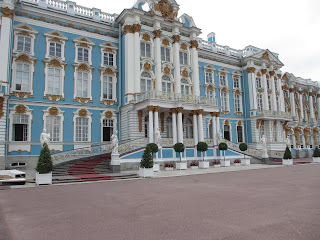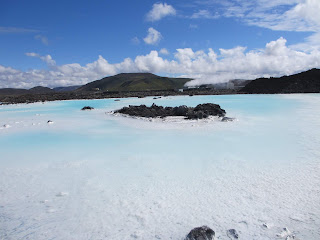IMPERIAL RUSSIA: ST PETERSBURG
"This is a city of half-crazy people... there
are few places where you'll find so many gloomy, harsh and strange influences
on the soul of a man as in St Petersburg." – Fyodor Dostoevsky, Crime and Punishment
A U.S. citizen is
required to obtain a visa in order to enter Russia. However, visitors on a
cruise ship may opt to be part of what is in essence a group visa: as long as
you stay with your licensed guide on an organized tour, you can be in the
country without an individual visa. Since I was signed up for several
excursions that qualified for this group visa, I opted to skip the individual
visa. If I had it to do over, I’d get the individual visa for this particular
cruise. Why? Our ship, being much smaller than the usual cruise ship, was able
to dock on the Neva River, right in the center of town and walking distance to
many sites. It was rather frustrating not to be able to just walk off the ship
and visit some of the places nearby that my tours did not go.
 |
| Catherine Palace |
That being said,
the places I did go were fascinating. First was Catherine Palace in the suburb
of Pushkin. This was the summer palace of the tsars, built in 1717 by Peter the
Great for his second wife, Catherine, who after his death became Empress
Catherine I. She was succeeded by her
daughter, Empress Elizabeth, who had much of the original structure demolished
and rebuilt to her taste. Elizabeth was succeeded by her son, Peter III, but
only for six months before he was assassinated. It is largely believed that
Peter III’s wife, Catherine, was responsible for his murder. In any event, she
certainly benefited from it: she succeeded him on the throne, ruling for three
decades as Empress Catherine II, later known as Catherine the Great.
 |
| Catherine the Great's coronation gown |
Catherine II then
had the palace renovated again to her own taste, but she was the last Russian
ruler to use it as a summer palace. Nevertheless, the structure stood for many
years until WWII, when it was severely damaged by retreating German
forces. Many of the palace’s treasures disappeared
at that time, some never to be found again. One of the most famous rooms was
the Amber Room, the walls of which were completely covered by intricate designs
of amber. The amber is believed to have been removed by the Nazis, but only one
or two of the pieces from it have ever been found. Nevertheless, the room has been reproduced
based on pictures and plans from the past, and is a magnificent sight.
Unfortunately, photographs were not allowed, and so I cannot share pictures
here.
The afternoon included
a visit to Yusopov Palace, the home of a family that was even wealthier than
the tsar. It also is supposedly the place where the “mad monk” (who was neither
mad nor a monk) Rasputin was assassinated. During the reign of the last tsar,
Nicholas II, Rasputin had attained considerable influence over the tsarina,
Alexandra, because of the relief that he managed to bring to her son Alexi.
Alexi suffered from hemophilia, and his mother credited Rasputin with calming
Alexi and easing his pain. It is widely thought that he did this through
hypnosis. Nevertheless, the aristocracy resented and feared Rasputin’s
influence, and were concerned that it fed into widespread dislike of Alexandra,
who was mistrusted because of her German background during the time of WWI.
Interestingly,
Rasputin wrote in letter to Alexandra dated December 7, 1916: “If I am killed by common assassins, and especially by my
brothers the Russian peasants, you, Tsar of Russia, have nothing to fear,
remain on your throne and govern, and you, Russian Tsar, will have nothing to
fear for your children, they will reign for hundreds of years in Russia. But if
I am murdered by boyars, nobles, and if they shed my blood, their hands will
remain soiled with my blood… : if it was your relations who have wrought my
death then no one of your family, that is to say, none of your children or
relations will remain alive for more than two years."
Rasputin was killed, purportedly by a group of Russian
nobles, including Yusopov, on December 30, 1916. The tsar’s and his family were killed by the Bolsheviks
on July 16, 1918—less than two years after Rasputin’s death. However, it is now
widely believed that Rasputin was actually killed by a British spy, and not Yusopov
and his friends.
Also interestingly, our guide told us the story of Yusopov and
friends as assassins while we were in the palace. When we returned to the bus,
she explained that that is the official story she is required to tell, but then
told the alternative story of the British assassin (which I had heard of from a
documentary).
 |
| One of the "running boys" |
Next was a canal cruise around the city. It was a great way to
see the sights. It also provided a phenomenon of great interest. The canal
boats sail under a series of bridges. At the first bridge, a couple of teenaged
boys stood on the bridge and waved at us. How nice. We all waved back. When we
got to the next bridge, there were the boys again. We then realized that they
were running alongside our boat, getting just enough ahead of us to go up onto
the next bridge to wave at us. They continued to do this throughout the trip,
which probably covered at least two miles. Our guide explained something we’d
already surmised—they’d be greeting us at the end, in hopes of getting some
money for their efforts. And, yes, we all gave them a bit of money. How could
we not admire their hard run and their creativity?
 |
| The throne in the Winter Palace from which Tsar Nicholas II announced Russia's entry into WWI |
The next day was a visit to the Hermitage, which is part of
the magnificent Winter Palace in the heart of the city. The building itself is
beautifully finished inside, making the structure itself a work of art. But
inside is a collection of 3 million pieces of art, assembled primarily by
Catherine the Great, that includes some of the world’s greatest works. It is
said that if one spent eight hours a day viewing each work of art for one
minute, it would take 17 years to see them all. We were fortunate to be allowed
in before the museum opened to the public, so that we had seen a number of the
highlights before the massive crowds entered. It was a terrific day, and a
great goodbye to a beautiful city.
 |
| Rubens' Rape of the Sabine Women, hanging in The Hermitage |



We took a Regent Baltic cruise a few years ago, and absolutely loved St. Petersburg. What's interesting to me is that we also took Regent's included excursions, but completely different ones than you took. It's amazing how much there is to see and do in St. Petersburg!
ReplyDeleteIn 2009, we took a Regent Choice excursion in the evening to the Catherine Palace and were able to take photographs in the Amber Room. The day excursions were not allowed to take photographs. I recognize that our trip was 10 years ago and many things change. I suggest checking this out if seeing the Amber Room is high on your list for St Petersburg
ReplyDelete